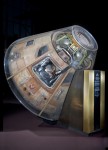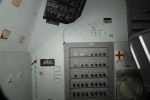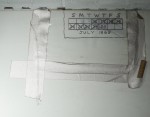 Smithsonian staff have discovered graffiti written on the inside walls of the Apollo 11 Command Module Columbia. The command module, the only part of the Apollo 11 spacecraft to return to Earth after Neil Armstrong took that giant step for mankind on July 20th, 1969, was transferred to the National Air and Space Museum in 1970. It is on display in the Milestones of Flight Hall but visitors and scholars can only see the outside of it. To allow people to explore the inside of the historic vessel, experts with the Smithsonian’s 3D Digitization Program have been 3D scanning the command module. It was during the scanning process that the notes left by Neil Armstrong, Buzz Aldrin and Michael Collins during the first manned lunar landing voyage were seen for the first time in 50 years.
Smithsonian staff have discovered graffiti written on the inside walls of the Apollo 11 Command Module Columbia. The command module, the only part of the Apollo 11 spacecraft to return to Earth after Neil Armstrong took that giant step for mankind on July 20th, 1969, was transferred to the National Air and Space Museum in 1970. It is on display in the Milestones of Flight Hall but visitors and scholars can only see the outside of it. To allow people to explore the inside of the historic vessel, experts with the Smithsonian’s 3D Digitization Program have been 3D scanning the command module. It was during the scanning process that the notes left by Neil Armstrong, Buzz Aldrin and Michael Collins during the first manned lunar landing voyage were seen for the first time in 50 years.
 The writings include numerical calculations, a calendar, labels and notes. One panel to left of the sextant and telescope has figures and other notes copied from Houston mission control audio transmissions. Researchers will compare the notes to recordings and transcripts of the voice transmissions to determine who took the notes, when and what the figures mean. Initial comparisons have already found that the notes on the right side of the lower panel are coordinates sent from mission control that were estimates (inaccurate ones, as it happens) of the Lunar Module’s location on the Moon. The main control panel is also peppered with notes, mainly numbers, which will also be compared to mission control records in order to figure out their meaning and author.
The writings include numerical calculations, a calendar, labels and notes. One panel to left of the sextant and telescope has figures and other notes copied from Houston mission control audio transmissions. Researchers will compare the notes to recordings and transcripts of the voice transmissions to determine who took the notes, when and what the figures mean. Initial comparisons have already found that the notes on the right side of the lower panel are coordinates sent from mission control that were estimates (inaccurate ones, as it happens) of the Lunar Module’s location on the Moon. The main control panel is also peppered with notes, mainly numbers, which will also be compared to mission control records in order to figure out their meaning and author.
 Some of the notes show how the astronauts had to think on their feet and improvise a little once they were in space. NASA had detailed lists of where everything was to be stored and there are stowage maps on the walls of the command module. The astronauts took liberties with the plans, however, and wrote their own labels on several of the lockers. One of the stowage lockers, for example, was meant to store equipment related to the waste management system, but the astronauts repurposed it to hold filled urine bags from launch day before the waste disposal system was operational. They wisely labeled the locker with its contents so there would be no nasty surprises.
Some of the notes show how the astronauts had to think on their feet and improvise a little once they were in space. NASA had detailed lists of where everything was to be stored and there are stowage maps on the walls of the command module. The astronauts took liberties with the plans, however, and wrote their own labels on several of the lockers. One of the stowage lockers, for example, was meant to store equipment related to the waste management system, but the astronauts repurposed it to hold filled urine bags from launch day before the waste disposal system was operational. They wisely labeled the locker with its contents so there would be no nasty surprises.
 The calendar is my favorite because it captures the very human excitement of the moment. It’s a small rectangle with two rows of seven boxes. Nine of the boxes have dates in them, the dates of the mission, July 16th through 24th. All of the dates are crossed out except for the last one. Splashdown day never did get crossed off.
The calendar is my favorite because it captures the very human excitement of the moment. It’s a small rectangle with two rows of seven boxes. Nine of the boxes have dates in them, the dates of the mission, July 16th through 24th. All of the dates are crossed out except for the last one. Splashdown day never did get crossed off.
“As curator of what is arguably one of the most iconic artifacts in the entire Smithsonian collection, it’s thrilling to know that we can still learn new things about Columbia,” said Allan Needell, curator of space history at the museum. “This isn’t just a piece of machinery, it’s a living artifact.”
 Laser scanning the interior and exterior of this living artifact has not been an easy task. Made primarily of aluminum alloy, stainless steel and titanium, the Apollo 11 command module is one big reflective surface which the scanners have difficulty reading. Add to that the complexity of the dashboards with their multiple small, delicate switches and indicators and buttons and the standard 3D capture tools weren’t going to cut it.
Laser scanning the interior and exterior of this living artifact has not been an easy task. Made primarily of aluminum alloy, stainless steel and titanium, the Apollo 11 command module is one big reflective surface which the scanners have difficulty reading. Add to that the complexity of the dashboards with their multiple small, delicate switches and indicators and buttons and the standard 3D capture tools weren’t going to cut it.
Because of the complicated nature of this scan, the Smithsonian 3D team brought in its technology partner, Autodesk Inc. Autodesk, a leader in cloud-based design and engineering software, deployed specially designed equipment to scan the artifact, and its advanced Memento software was able to process complex data from multiple 3-D capture devices to create one highly detailed and accurate model.
The model is a work in progress at the moment. It’s scheduled to be completed in June when it will be uploaded to the Smithsonian’s excellent 3d.si.edu site. That same month a major renovation of the Milestones of Flight Hall will be finished and the Apollo 11 Command Module will be temporarily taken off view. It will go back on display in 2020 in the museum’s new, state-of-the-art Destination Moon exhibition. The 3D model will be used to create an interactive display for the new exhibition.
Here is an early preview of the 3D model still in progress.
[youtube=https://youtu.be/lAMkeHqXgL0&w=430]
Thank you for this very interesting post which I think most people will enjoy reading.
Just occasionally I think “Who cares”? I mean, where they stored their pee? Did no one think of asking them?
“Professor Armstrong, where did you store that urine? I think we should be told.” The good Professor: “Oh piss off!”
Lunar Module coordinates should almost certainly be written by Michael Collins. He was tasked with trying to visually spot the LM on the surface while he passed over it alone in the CM, to try and ascertain the precise touchdown point, and for that Houston on occasion radioed some latest best coordinate estimates for him to look. He quite probably just noted them down on the spot as he got them, before grabbing his own maps to check where exactly that new spot for him to look at is.
It’s strange how slapdash some of the white paint on the interior looks. At first I thought it was a poor restoration job but the penciled numbers from the astronauts are on top of the white paint. I wonder if the sloppy painting was a result of the haste of the “space race.”